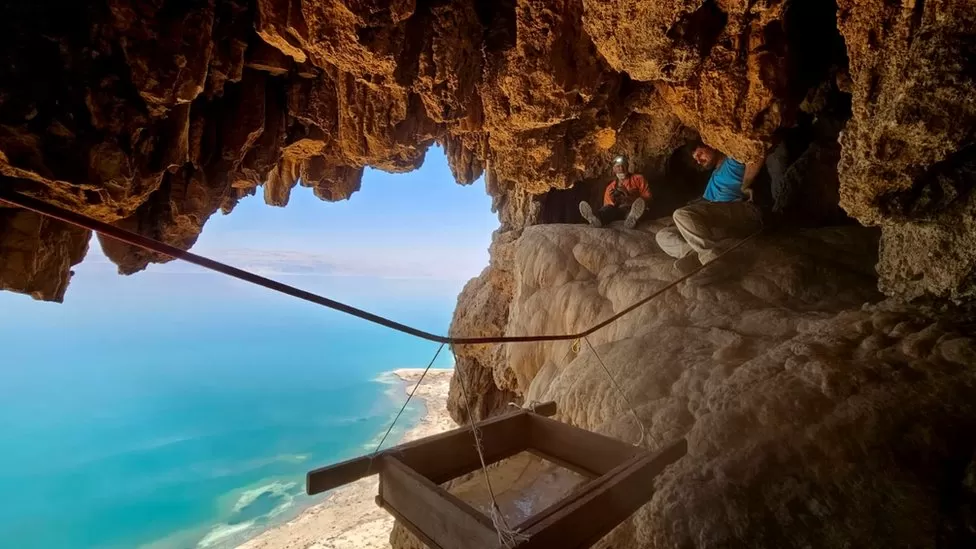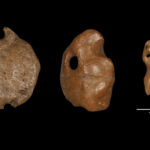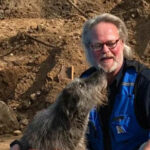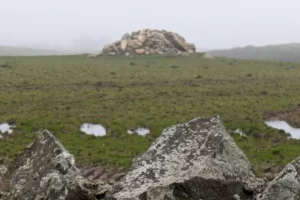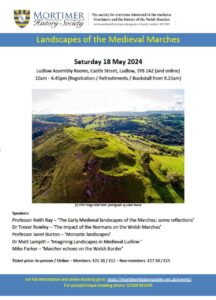
Title: Roman swords discovered in Dead Sea cave 1,900 years after Jewish rebellion
Date: September 6, 2023
Source: NBC News
Summary:
Israeli archaeologists have unveiled the discovery of four exceptionally well-preserved Roman swords in a secluded cave overlooking the Dead Sea. These nearly 2,000-year-old weapons, believed to have been pilfered from Roman soldiers by Jewish rebels, were found in pristine condition. The discovery was made while experts were inspecting an ancient Hebrew inscription in the cave. The swords, three of which were still in their scabbards, are thought to be linked to the Bar Kokhba Revolt in 132-135 A.D., as evidenced by a coin from that era found near the cave entrance. The dry desert conditions of the Judean Desert have allowed these artifacts to remain intact over millennia. The Israel Antiquities Authority continues its extensive survey in the region to deter looting and uncover more historical treasures. Read more… and Read more…
Title: Archaeologists unearth complete Neolithic cursus in Arran in major excavation
Date: 4th September 2023
Source: The National
 Summary:
Summary:
On the Isle of Arran, archaeologists have started revealing what is believed to be Britain’s only complete Neolithic cursus. This excavation, initiated in August at Drumadoon, is unearthing an ancient ceremonial monument dating from 4000 to 3000 BC. Cursus structures, vast rectangular enclosures, were constructed as spaces for ceremonies, processions, and gatherings. The well-preserved Arran cursus, approximately 1.1km long, is near Machrie Moor’s stone circles, a significant ancient ceremonial site. Kenny Brophy, an archaeology lecturer, emphasized the labour intensity of its creation, suggesting that Neolithic individuals used basic tools like sticks and bones. The cursus’s discovery was facilitated by a Lidar survey by Historic Environment Scotland five years prior. Read more… and Read more…
Title: New discovery shows this Scottish island is a prehistoric treasure trove
Date: 5th September 2023
Source: The National
Summary:
While Orkney is renowned for its Neolithic sites, the Isle of Arran has recently emerged with a significant discovery, further establishing its place on the global map of Neolithic sites. Researchers have identified what is believed to be a Neolithic cursus, a massive monument constructed by early farmers. This cursus, possibly the only complete one in Britain, spans 1.1km by 50m and is surrounded by a large stone, earth, and turf bank. It might date back to 3500 BC, predating both Stonehenge and Orkney’s Ring of Brodgar. Gavin Macgregor of Archaeology Scotland emphasized the immense labour involved in its creation and its potential to shed light on early Neolithic farming and social structures. The discovery suggests that Arran’s landscape might be part of a broader ceremonial complex. Read more…
Title: Neanderthal flower burial theory called into question by new study
Date: September 6, 2023
Source: CNN
 Summary:
Summary:
A grave discovered in 1960 led to the hypothesis that Neanderthals buried their dead with flowers, challenging the notion of them being primitive. This theory stemmed from the “flower burial” found in Shanidar Cave, Kurdistan, where a Neanderthal skeleton, Shanidar 4, was surrounded by pollen. Initially, it was believed that Neanderthals placed flowers on the grave. However, a new study suggests that the pollen might have been brought by cave-dwelling pollinators, like bees. This research doesn’t refute the idea that Neanderthals treated their dead with care, but it does challenge the flower burial hypothesis. The cave’s skeletons were interred separately, years apart, hinting at a significant burial process. Read more…
Title: Early humans ‘were intentionally crafting stone balls 1.4 million years ago’
Date: September 5, 2023
Source: Express & Star
 Summary:
Summary:
Early humans, around 1.4 million years ago, were intentionally crafting spherical shapes, showcasing their appreciation for geometry and symmetry. This revelation comes from an analysis of 150 limestone balls or spheroids found in ‘Ubeidiya, an archaeological site in the Jordan Rift Valley, Israel. The study challenges the previous belief that these spheroids were mere by-products of other tasks. The researchers from The Hebrew University of Jerusalem used advanced 3D analysis methods to understand the crafting process. While the exact purpose of these spheroids remains uncertain, the findings suggest that early humans had a clear goal of achieving a spherical shape, requiring exceptional skills. Read more…
Title: Detectorist’s ‘chocolate money’ horde dubbed Norway’s gold find of the century
Date: September 7, 2023
Source: The National
 Summary:
Summary:
In a remarkable discovery on the southern island of Rennesoey, near Stavanger, Norwegian metal detectorist Erlend Bore unearthed what he initially believed to be chocolate money. However, it turned out to be a significant find consisting of nine pendants, three rings, and 10 gold pearls, now hailed as Norway’s gold discovery of the century. Bore, who took up metal detecting as a hobby earlier this year, was astounded by the find. Experts from the Archaeological Museum at the University of Stavanger described the discovery as “extremely unusual.” The gold pendants, known as bracteates, date back to around AD500, during Norway’s Migration Period. These artifacts, believed to be part of a lavish necklace, offer a unique insight into the craftsmanship and societal structures of the time. Read more…
I trust you find these examples of archaeology extracted from various media sources, interesting. While the sources have been carefully selected, CBAWales do not vouch for them – they are simply a guide to articles you may otherwise have missed.

